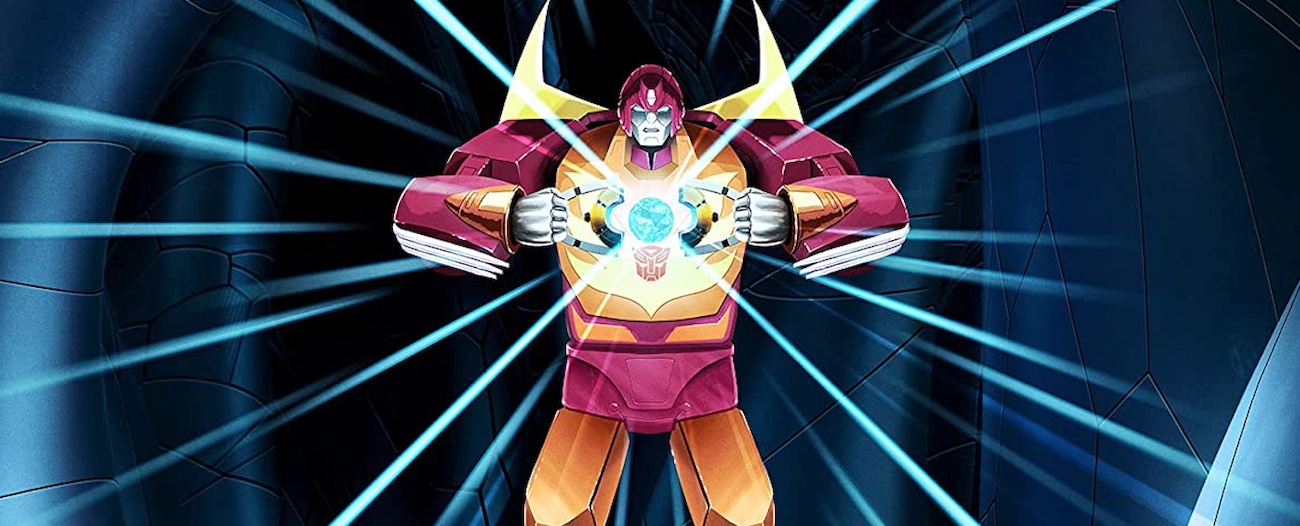How ‘Transformers: The Movie’ traumatized kids and trained a generation of filmmakers
Optimus Prime's death in 'Transformers: The Movie' scarred a generation of kids and showed storytellers what they could and couldn't do with beloved characters.

As hyperbolic as it sounds, Transformers: The Movie traumatized an entire generation of children. The death of Optimus Prime was a formative event for many, many kids who had never watched a story where something like that happened with a character, much less possibly the most iconic character in the series upon which that story was based. It also exposed some interesting, and even vital fault lines between the people who created children’s entertainment, the companies creating merchandise around that entertainment, and the young fans that consumed both. As Transformers: The Movie celebrates its 35th anniversary on August 8, What To Watch takes a look back at the film and the creative choices that affected not only this massively popular series but the future creation of stories aimed at audiences of certain ages — and how that affected audiences of all ages.
Written by Ron Friedman and directed by Nelson Shin, Transformers: The Movie arrived in theaters almost two years after the animated series upon which it was based, The Transformers, first premiered on television. Like many shows of that era, The Transformers was based on a toy line — and that toy line was based on not one but two other toy lines, Diaclone and Microman, the mecha-themed creations of Japanese company Takara. The reason why this history is important is because it is that pipeline, mostly derived from Takara’s creations, that effectively drove the stories told in the syndicated series. After U.S. regulators removed many of the restrictions around product and promotional placement in children’s programming, Hasbro enlisted Marvel Comics to develop a comic tie-in, and eventually, the mythology upon which decades of stories would be based: two warring factions of robotic sentient robots, the Autobots and Decepticons, crash down on earth, where they continue their ages-old conflict.
Hasbro had released two series of toys by the time Transformers: The Movie was released, which included 104 characters in total. The film would mark a transition for Hasbro to start using more original designs for its toys, and with so many already being used, the company decided to kill off several of the foundational characters. The problem with this was, first, one of precedent; the Transformers syndicated series never killed off characters, and had told 65 stories that explored the identity and personalities to make even the smaller and less significant ones familiar or beloved. But second, these story choices would likely mark the first time that the child audiences that collected the toys would experience a death scene.
Certainly Disney had ventured into darker territory in the late 1970s and early ‘80s with its storytelling, and there were some live action films like E.T. that skillfully navigated perilous scenarios for their characters but arrived at safer, happier places by the end. But even (or especially) 35 years later, Optimus Prime’s death remains an astonishing spectacle in a cartoon clearly made for kids that looks a little more polished than the series it was based upon but for the most part duplicated its colors, its lighting, and its tone. I remember being shocked as a kid just that the characters used profanity for the first time, but it was nothing short of devastating to watch Prime lay on a cold slab as his vitals slow to a flat line, the blue glow of his eyes flicker out, and his body turns grey.
With a future toy line to showcase, Prime wasn’t the only Transformer who died in the film — and he wasn’t even the first: in an opening scene, Megatron and the Decepticons intersect an Autobot shuttle and they do everything to its crew except take prisoners. And later, Megatron and a few of his henchmen suffer a fate similar to his iconic adversary. But they are almost immediately transformed into their next-generation versions, where by comparison moviegoers get to watch Optimus Prime’s “soul leave his body,” as director Shin described it. It subsequently came as little surprise that critics were either baffled or appalled by the film, which they characterized as a feature-length toy ad, which of course it was. But what’s more unexpected is how unprepared the storytellers were to the backlash that ensued by killing off these iconic characters, starting with children themselves and inevitably moving on to parents furious about having to console or explain mortality after taking their children to the feature-length toy ad.
G.I. Joe: The Movie followed soon after; in fact, it was supposed to be released first, but production delays held it up, and the box office failure of Transformers: The Movie prompted them to rejigger it for direct-to-video. But those obstacles ended up giving the production time to react to the criticisms of Transformers — in particular, viewers’ profound disappointment that a beloved character died. They had similarly embarked on a throat-clearing exercise with G.I. Joe, with the plan to kill off none other than Duke, effectively the main character in the series. In the film, Duke is seriously wounded and goes into a coma, but because of Transformers: The Movie, uncredited screenwriter Buzz Dixon created replacement dialogue after what was supposed to be his death scene — which is still in the film — that first indicates he has gone into a coma, and later, that he successfully recovered from it, although he is never seen again.
After that, very few children’s oriented stories even went near topics like death, although of course they were willing to explore war, violence and destruction. Pain and fear were systematically eliminated as tools, much less consequences, for characters in kids’ shows and movies, unless they were used in the service of telling some sort of lesson. Especially in animation, when you watch a younger character get subjected to some form of violence, their reaction is almost invariably one of indifference, and often of enjoyment. In an early scene in The Angry Birds Movie, for example, Red punts a little blue bird who disturbed his sleep into the ocean, and the film makes a special effort to indicate that the little bird enjoyed the experience. Even where the character’s aggression is the cornerstone of the plot, the recipient of his rage is unbothered, and even delighted, by how he expresses it. And the original Despicable Me works overtime to highlight just how much fun Gru’s orphans are having at all times, no matter what sort of dangerous scenario his choices might have landed them all in.
The latest updates, reviews and unmissable series to watch and more!
Of course, these are just children’s stories, and so it is by necessity and as a hallmark of progress in family entertainment that risk, danger, and sadness should be minimized or eliminated. But it is choices like these that have prompted studios to monitor and refine and change stories in order to not “upset” viewers who may not be able to handle situations that are too intense. And so instead of nailbiter action scenes in movies designed for broad audiences, those viewers get ones joked through with ironic detachment to guarantee that the youngest viewers won’t get too afraid while Scarlett Johansson is rescuing her father from a Siberian prison, and so forth. Or worse, they lead filmmakers to choices that bleed suspense and emotional depth out of their stories after they may happen upon an intriguing or provocative idea.
You cannot watch J.J. Abrams’ movies, for example, and believe that he has any confidence in the intelligence of his audiences, or possibly he fears that Transformers: The Movie backlash if he does not gratify or reassure them immediately. In Star Trek Into Darkness, he recalibrates the death of Spock from Star Trek II: The Wrath of Khan to become the death of Kirk, and then immediately bails out of that choice — with a “Khan’s blood” deus ex machina that never gets adequately explained — despite the fact that it provides a tremendous emotional crescendo for the film and an even bigger enticement to see the next one when it comes out. And then in Star Wars: The Rise of Skywalker, he makes the decision to kill off Chewbacca for about a minute of screen time before revealing that he is absolutely fine; few experiences can be as galvanizing for a character’s sense of motivation or purpose than a profound loss — which is exactly why it works within Transformers: The Movie, regardless of its “toy commercial” origins — but he undercuts his characters and his own story to comfort and reassure viewers that he would never do something to truly upset them, at least not for more than a minute.
Shout Factory’s new 4K release of Transformers: The Movie is truly remarkable, and gives Nelson Shin’s animation a luster it’s never had before. But the film’s legacy endures for more and better reasons than the subsequent cartoons and film series (and yes, toys) that it inspired. Even as a feature-length toy ad, it successfully explores the notion of generational change, of discovering what it means to inspire others, and to both literally and metaphorically inherit the mantle and responsibilities of leadership. (Also, it features the final performances of actors Orson Welles and Scatman Crothers, its soundtrack is delightfully pure 1980s cheese, and it’s a surprising lot of fun.) And ultimately, the only way that the movie’s perhaps most thoughtless choice truly ever qualified as a mistake was when it was decided that in order to prevent kids from seeing something that might force them to grow up just a little bit before they’re ready, generations of filmmakers would do everything they can to protect audiences — of any age — from having to grow up at all.
Todd Gilchrist is a Los Angeles-based film critic and entertainment journalist with more than 20 years’ experience for dozens of print and online outlets, including Variety, The Hollywood Reporter, Entertainment Weekly and Fangoria. An obsessive soundtrack collector, sneaker aficionado and member of the Los Angeles Film Critics Association, Todd currently lives in Silverlake, California with his amazing wife Julie, two cats Beatrix and Biscuit, and several thousand books, vinyl records and Blu-rays.


